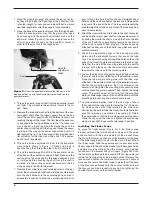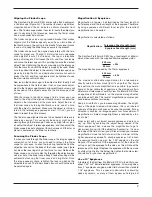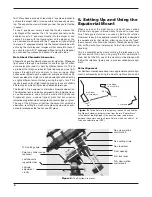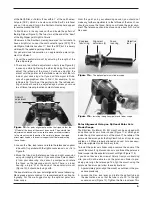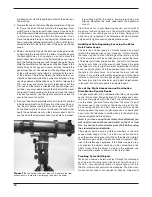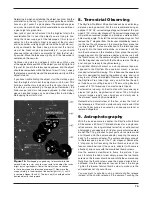
11
appear to move faster at higher magnifications, because the
field of view is narrower.
optional Motor Drives for automatic tracking
An optional DC motor drive can be mounted on the R.A.
axis of the equatorial mount to provide hands-free tracking.
Objects will then remain stationary in the field of view without
any manual adjustment of the right ascension slow-motion
control knob.
understanding the setting circles
The setting circles on an equatorial mount enable you to
locate celestial objects by their “celestial coordinates”. Every
object resides in a specific location on the “celestial sphere”.
That location is denoted by two numbers: its right ascension
(R.A.) and declination (Dec.). In the same way, every loca-
tion on Earth can be described by its longitude and latitude.
Right ascension is similar to longitude on Earth, and declina-
tion is similar to latitude. The R.A. and Dec. values for celestial
objects can be found in any star atlas or star catalog.
The R.A. setting circle is scaled in hours, from 1 through 24,
with small marks in between representing 10-minute incre-
ments (there are 60 minutes in 1 hour of right ascension).
The lower set of numbers apply to viewing in the Northern
Hemisphere, while the numbers above them apply to viewing
in the Southern Hemisphere. The location of the right ascen-
sion coordinate indicator arrow is shown in Figure 13.
The Dec. setting circle is scaled in degrees, with each mark
representing 2° increments. Values of declination coordinates
range from +90° to -90°. The 0° mark indicates the celestial
equator. When the telescope is pointed north of the celestial
equator, values of the declination setting circle are positive;
when the telescope is pointed south of the celestial equator,
values of the declination setting circle are negative.
So, the coordinates for the Orion Nebula listed in a star atlas
will look like this:
R.A. 5h 35.4m Dec. - 5° 27'
That’s 5 hours and 35.4 minutes in right ascension, and -5
degrees and 27 arc-minutes in declination (there are 60 arc-
minutes in 1 degree of declination).
Before you can use the setting circles to locate objects, the
mount must be accurately polar aligned, and the setting cir-
cles must be calibrated.
calibrating the Declination setting circle
1. Loosen the Dec. lock lever and position the telescope as
accurately as possible in declination so it is parallel to the
R.A. axis as shown in Figure 1. Re-tighten the lock lever.
2. Loosen one of the thumb screws on the Dec. setting circle,
this will allow the setting circle to rotate freely. Rotate the
Dec. setting circle until the pointer reads exactly 90°. Re-
tighten the setting circle thumb screw.
calibrating the right ascension setting circle
1. Identify a bright star in the sky near the celestial equator
(declination = 0°) and look up its coordinates in a star
atlas.
2. Loosen the R.A. and Dec. lock levers on the equatorial
mount, so the telescope optical tube can move freely.
3. Point the telescope at the bright star whose coordinates
you know. Center the star in the telescope’s field of view.
Lock the R.A. and Dec. lock levers.
4. Loosen one of the R.A. setting circle thumb screws (see
Figure 13); this will allow the setting circle to rotate freely.
Rotate the setting circle until the R.A. pointer arrow indi-
cates the R.A. coordinate listed in the star atlas for the
object. Retighten the setting circle thumb screw.
Finding objects With the setting circles
Now that both setting circles are calibrated, look up in a star
atlas the coordinates of an object you wish to view.
1. Loosen the Dec. lock lever and rotate the telescope until
the declination value from the star atlas matches the read-
ing on the Dec. setting circle. Remember that values of the
Dec. setting circle are positive when the telescope is point-
ing north of the celestial equator (Dec. = 0°), and negative
when the telescope is pointing south of the celestial equa-
tor. Retighten the lock lever.
2. Loosen the R.A. lock lever and rotate the telescope until the
right ascension value from the star atlas matches the read-
ing on the R.A. setting circle. Remember to use the lower
set of numbers on the R.A. setting circle. Retighten the lock
lever.
Most setting circles are not accurate enough to put an object
dead-center in the telescope’s eyepiece, but they should place
the object somewhere within the field of view of the finder
scope, assuming the equatorial mount is accurately polar
aligned. Use the slow-motion controls to center the object in
the finder scope, and it should appear in the telescope’s field
of view.
Figure 13.
The R.A. and Dec. setting circles.
Dec. setting
circle
Dec. setting
circle
thumbscrew
(2)
Dec.
indicator
arrow
R.A.
indicator
arrow
R.A. setting circle
thumbscrew (2)
R.A.
setting
circle




